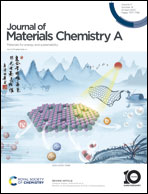Synthesis of high-purity Li2S nanocrystals via metathesis for solid-state electrolyte applications†
Abstract
Li2S is the key precursor for synthesizing thio-LISICON electrolytes employed in solid state batteries. However, conventional synthesis techniques such as carbothermal reduction of Li2SO4 aren't suitable for the generation of low-cost, high-purity Li2S. Metathesis, in which LiCl is reacted with Na2S in ethanol, is a scalable synthesis method conducted at ambient conditions. The NaCl byproduct is separated from the resulting Li2S solution, and the solvent is removed by evaporation and thermal annealing. However, the annealing process reveals the presence of oxygenated impurities in metathesis Li2S that are not usually observed when recovering Li2S from ethanol. In this work we investigate the underlying mechanism of impurity formation, finding that they likely derive from the decomposition of alkoxide species that originate from the alcoholysis of the Na2S reagent. With this mechanism in mind, several strategies to improve Li2S purity are explored. In particular, drying the metathesis Li2S under H2S at low temperature was most effective, resulting in high-purity Li2S while retaining a beneficial nanocrystal morphology (∼10 nm). Argyrodite electrolytes synthesized from this material exhibited essentially identical phase purity, ionic conductivity (3.1 mS cm−1), activation energy (0.19 eV), and electronic conductivity (6.4 × 10−6 mS cm−1) as that synthesized from commercially available battery-grade Li2S.

- This article is part of the themed collection: #MyFirstJMCA


 Please wait while we load your content...
Please wait while we load your content...